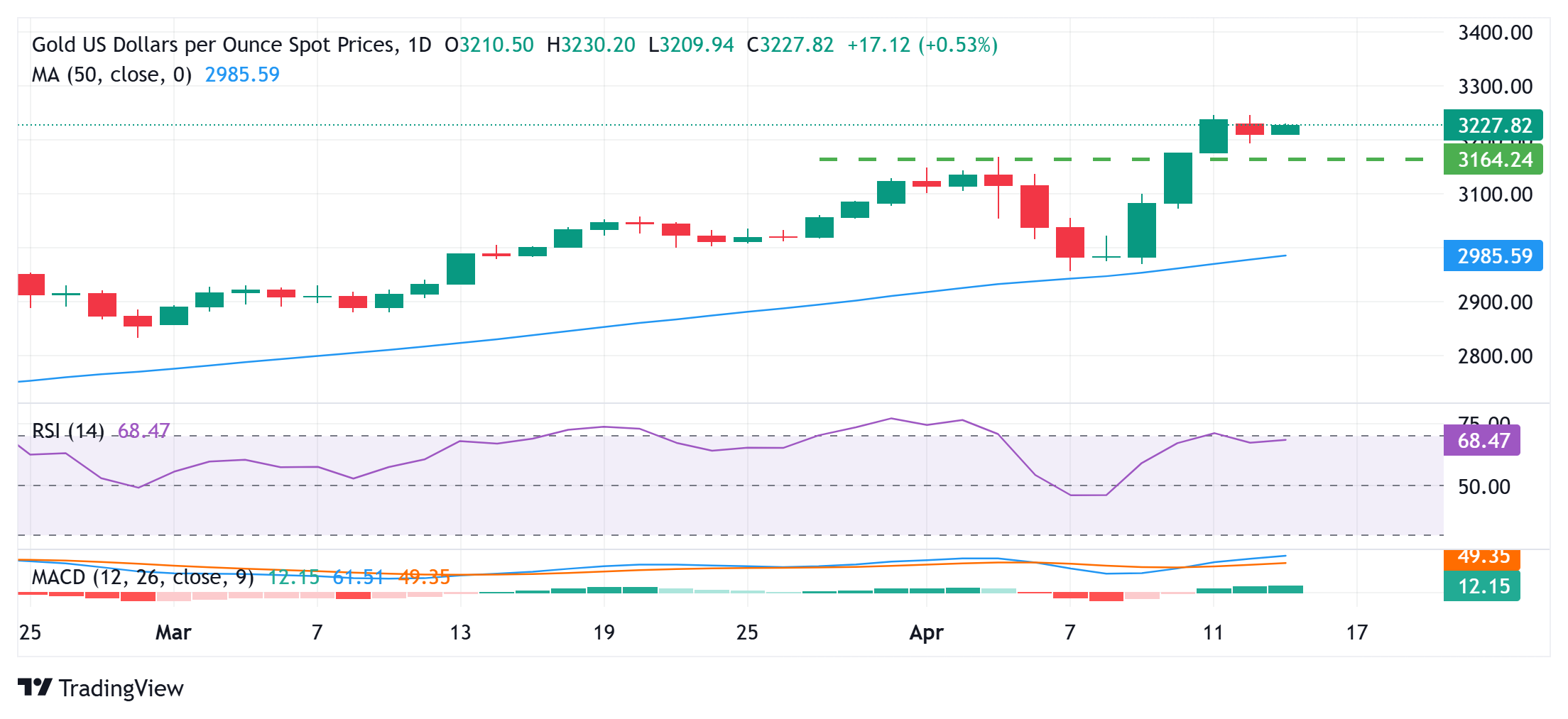-
Gold price gains positive momentum as ongoing US tariff uncertainty supports demand for safe-haven assets.
-
Expectations of aggressive Fed rate cuts in 2025 weigh on the USD, providing additional support to XAU/USD.
-
Trump's temporary tariff pause boosts global risk sentiment, potentially limiting further upside for the metal.
Gold (XAU/USD) continues to trade with a firm tone around the $3,225 level heading into Tuesday’s European session. While the precious metal holds above the $3,200 mark, it lacks strong follow-through buying and remains below the record high set on Monday. Market sentiment remains cautiously optimistic following US President Donald Trump’s temporary suspension of tariffs on key consumer electronics and hints at potential exemptions for the auto industry from the 25% levies. This improvement in risk appetite has limited investors' appetite for new bullish positions in gold.
Nevertheless, intensifying concerns over the US-China trade war and its potential impact on global economic growth continue to support demand for safe-haven assets like gold. Adding to this, growing expectations for aggressive monetary easing by the Federal Reserve in 2025—amid a persistently weak US Dollar—serve as additional tailwinds for the non-yielding yellow metal. As a result, the broader outlook for gold remains tilted to the upside.
Daily Market Drivers: Gold Retains Positive Bias
-
Safe-haven demand stays strong as US-China trade tensions escalate. On Friday, China retaliated against Washington by raising tariffs on US imports to as high as 125%, following Trump’s decision to hike duties on Chinese goods to a record 145%. This tit-for-tat move has kept gold prices near all-time highs.
-
The US still depends heavily on critical imports from China, denting confidence in the American economy. Recession fears have been revived, with expectations that the Fed may slash interest rates at least three times in 2025. These factors have pressured the US Dollar, which struggles to stage a meaningful recovery.
-
Fed officials have expressed growing concerns over Trump’s tariff plans. Governor Christopher Waller warned that the tariffs could deliver a significant economic shock, potentially forcing the Fed to act. Meanwhile, Atlanta Fed President Raphael Bostic emphasized inflation concerns tied to rising import costs, suggesting that the central bank faces limited policy flexibility.
-
Risk sentiment improved somewhat after the White House announced temporary tariff exemptions on electronics like smartphones and computers. Trump also suggested similar relief could be extended to the auto sector to help companies adapt. However, he maintained a hard stance, indicating plans to impose fresh tariffs on semiconductors soon, along with potential duties on pharmaceuticals. This persistent uncertainty continues to support safe-haven flows into gold.
-
Traders are now eyeing Tuesday’s US economic releases, including the Empire State Manufacturing Index. More significantly, Fed Chair Jerome Powell’s speech on Wednesday will be closely watched for insights into future interest rate policy, which could be a key driver for the next move in gold.
Technical Outlook: Bulls in Control Above $3,168 Support

Gold’s ability to bounce back from levels just below $3,200 suggests that the bullish trend remains intact. While the daily Relative Strength Index (RSI) flirts with overbought territory—pointing to possible short-term consolidation or a modest pullback—the broader trajectory favors the bulls.
Immediate resistance is seen near the $3,245–$3,246 region, which marks the previous record high. A sustained break above this level could pave the way for further gains.
On the downside, any dip below $3,200 is likely to attract buying interest and find support near the $3,168–$3,167 zone. This area serves as a critical pivot for short-term traders. A decisive drop below this zone could trigger deeper corrective losses, with the next supports located around $3,136, followed by $3,115 and the psychologically important $3,100 mark.





